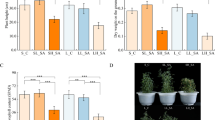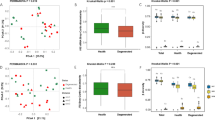Abstract
Fusarium palustre is an endophyte/pathogen of Spartina alterniflora, a saltmarsh grass native to North America that has been associated in the USA with a saltmarsh decline known as Sudden Vegetation Dieback (SVD). Since the intentional introduction of S. alterniflora to stabilize mud flats on Chongming Island, Shanghai, China, S. alterniflora has become invasive, but shows no symptoms of dieback even though F. palustre can be isolated from the plant. When declining S. alterniflora from SVD sites in the northeastern USA were assayed for Fusarium species, an average of 8 % of tissues sampled gave rise to a species of Fusarium of these, 64 % were F. palustre and 16 % were F. incarnatum, a nonpathogenic species. To determine if low densities of F. palustre could explain the lack of dieback symptoms on S. alterniflora from Chongming Island, we assessed the incidence and distribution of Fusarium spp. on S. alterniflora from 12 sites on Chongming Island. On average, 26 % of the stem and root tissues sampled were colonized by a Fusarium species. Of 196 isolates recovered from S. alterniflora, 44 % were F. incarnatum and 41 % were F. palustre. Species determinations were confirmed for a subset of these isolates using a phylogenetic analysis of partial sequences of the translation elongation factor (tef) gene. The observation that Fusarium incidence on S. alterniflora was much greater on Chongming Island than in the USA survey raises the question as to why S. alterniflora on Chongming Island is showing no dieback. Other factors, such as predator release, enhanced nutritional, edaphic and/or other unidentified environmental constraints on Chongming Island may afford S. alterniflora protection from dieback.


Similar content being viewed by others
References
Alber M, Swenson EM, Adamowicz SC, Mendelssohn IA (2008) Salt marsh dieback: an overview of recent events in the US. Estuar Coast Shelf Sci 80:1–11
An SQ, Gu BH, Zhou CF, Wang ZS, Deng ZF, Zhi YB, Li HL, Chen L, Yu DH, Liu YH (2007) Spartina invasion in China: implications for invasive species management and future research. Weed Res 47:183–191
Anagnostakis SL (1987) Chestnut blight: the classical problem of an introduced pathogen. Mycologia 79:23–37
Castellá G, Cabañes FJ (2014) Phylogenetic diversity of Fusarium incarnatum-equiseti species complex isolated from Spanish wheat. Antonie Van Leeuwenhoek. doi:10.1007/s10482-014-0200-x
Chen ZY, Li B, Zhong Y, Chen JK (2004) Local competitive effects of introduced Spartina alterniflora on Scirpus mariqueter at Dongtan of Chongming Island, the Yangtze River estuary and their potential ecological consequences. Hydrobiologia 528:99–106
Datnoff LE, Elmer WH, Huber DN (2007) Mineral nutrition and plant disease. APS Press, St. Paul
Elmer WH, LaMondia JA (2014) Comparison of saline tolerance of genetically similar species of Fusarium and Meloidogyne recovered from marine and terrestrial habitats. Estuar Coast Shelf Sci 149:320–324
Elmer WH, Marra RE (2011) New species of Fusarium associated with dieback of Spartina alterniflora in Atlantic salt marshes. Mycologia 103:806–819
Elmer WH, LaMondia JA, Caruso F (2011) Association between Fusarium spp. on Spartina alterniflora and dieback sites in Connecticut and Massachusetts. Estuaries Coasts 35:436–444
Elmer WH, Useman S, Schneider RW, Marra RE, del Mar LaMondiaJA, Jimenez-Gasco M, Mendelssohn IA, Caruso FL (2013) Sudden Vegetation Dieback in Atlantic and Gulf coast salt marshes. Plant Dis 97:436–444
Flory SL, Clay K (2013) Pathogen accumulation and long-term dynamics of plant invasions. J Ecol 101:607–613
Guindon S, Gascuel O (2003) A simple, fast and accurate algorithm to estimate large phylogenies by maximum likelihood. Syst Biol 52:696–704
Leslie JF, Summerell BA (2006) The fusarium laboratory manual. Blackwell, Ames, p 385
Li B, Liao CZ, Zhang XD, Chen HL, Wang Q, Chen ZY (2009) Spartina alterniflora invasions in the Yangtze River estuary, China: an overview of current status and ecosystem effects. Ecol Eng 35:511–520
Li H, Shao JJ, Qiu SY, Li B (2013) Native Phragmites dieback reduced its dominance in the salt marshes invaded by exotic Spartina in the Yangtze River estuary, China. Ecol Eng 57:236–241
Li H, Zhang X, Zheng R, Li X, Elmer WH, Wolfe LM, Li B (2014) Li Indirect effects of non-native Spartina alterniflora and its fungal pathogen (Fusarium palustre) on native salt marsh plants in China. J Ecol 102:1112–1119
Mack RN, Simberloff D, Lonsdale WM, Evans H, Clout M, Bazzaz FA (2000) Biotic invasions: causes, epidemiology, global consequences, and control. Ecol Appl 10:689–710
O’Donnell K, Cigelnik E, Nirenberg HI (1998) Molecular systematics and phylogeography of the Gibberella fujikuroi species complex. Mycologia 90:465–493
O’Donnell K, Sutton DA, Rinaldi MG, Gueidan C, Crous PW, Geiser DM (2009) Novel multilocus sequence typing scheme reveals high genetic diversity of human pathogenic members of the Fusarium incarnatum–F. equseti and F. chlamydosporum species complexes within the United States. J Clin Microbiol 47:3851–3861
Potter C, Harwood T, Knight J, Tomlinson I (2011) Learning from history, predicting the future: the UK Dutch elm disease outbreak in relation to contemporary tree disease threats. Phil Trans R Soc Lond Ser B Biol Sci 366:1966–1974
Schwarz GE (1978) Estimating the dimension of a model. Ann Stat 6(2):461–464
Seem RC (1984) Disease incidence and severity relationships. Ann Rev Phytopathol 22:133–150
Strauss A, White A, Boots M (2012) Invading with biological weapons: the importance of disease-mediated invasions. Funct Ecol 26:1249–1261
Tamura K, Nei M, Kumar S (2004) Prospects for inferring very large phylogenies by using the neighbor-joining method. Proc Natl Acad Sci USA 101:11030–11035
Tamura K, Stecher G, Peterson D, Filipski A, Kumar S (2013) MEGA6: molecular evolutionary genetics analysis version 6.0. Mol Biol Evol 30:2725–2729
Wilcove DS, Rothstein D, Dubow J, Phillips A, Losos E (1998) Quantifying threats to imperiled species in the United States. Bioscience 48:607–615
Xu HF, Zhao YL (2005) Comprehensive surveys in Chongming Dongtan Nature Reserve for Migratory Birds, Shanghai (in Chinese). Chinese Forestry Publishing House, Beijing
Acknowledgments
The authors thank Peter Thiel and Michael Ammirata for Technical assistance. This work was funded in part from USDA Hatch Grant H 647.
Author information
Authors and Affiliations
Corresponding author
Additional information
Guest editors: Alan Gray and Malika Ainouche/Invasive Spartina.
Rights and permissions
About this article
Cite this article
Elmer, W.H., Marra, R.E., Li, H. et al. Incidence of Fusarium spp. on the invasive Spartina alterniflora on Chongming Island, Shanghai, China. Biol Invasions 18, 2221–2227 (2016). https://doi.org/10.1007/s10530-015-1012-2
Received:
Accepted:
Published:
Issue Date:
DOI: https://doi.org/10.1007/s10530-015-1012-2




